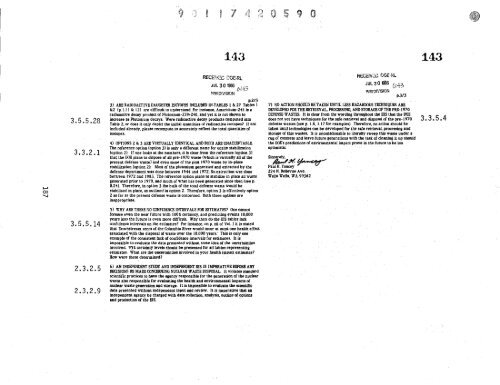EIS-0113_Section_9 - Hanford Site
EIS-0113_Section_9 - Hanford Site
EIS-0113_Section_9 - Hanford Site
You also want an ePaper? Increase the reach of your titles
YUMPU automatically turns print PDFs into web optimized ePapers that Google loves.
is<br />
443<br />
143<br />
N<br />
W<br />
V<br />
3.5.5.28<br />
3.3.2.1<br />
RECEVEr COE-RL<br />
JUL 301966<br />
6 l}3<br />
IMM DIVISION<br />
V.2/3<br />
3) ARE RADIOACTIVE DAUGHTER ISOTOPES INCLUDED IN-TABLES I & 2? Tables 1<br />
&2 (p. 1.11 & 12) are d ifficult to understand. For instance, Americium-241 is a<br />
radioactive decay product of Plutonium-239-240, and yet it is not shown to<br />
increase. as Plutonium decays. Were radioactive decay products Computed into<br />
Table 2, or does it only depict Me initial quantities m radioactive isotopee? If not<br />
included already, please recompute to accurately reflect the total quantities of<br />
isotopes<br />
4) OPTIONS 2. & 3 ARE VIRTUALLY IDENTICAL AND BOTH ARE UNACCEPTABLE.<br />
The reference option (option 3) is only a d ifferent name for onsite stabilization<br />
(option 2). If one looks at the numbers, it is clear from the reference (option 3)<br />
that the DOB plans to dispose of all pre-1970 waste (which is virtually all of the<br />
present defense waste) and even some of the post 1970 waste by 1n-p12ce<br />
stabilization (option 2): Most of the plutonium generated and extracted by the<br />
defense department was done between 1944 and 1972; No extraction was done<br />
between 1972 and 1983.: The reference option plans to stabilize in place all waste<br />
generated prior to 1970, and much of what has been generated since then (see p.<br />
11,24). Therefore, in option. 3. the bulk of the total defense waste would be<br />
stabilized in place, as outlined in option 2. Therefore. option 3 is effectively option<br />
2 as far as the present defense waste is Concerned. Both these options are<br />
inappropriate.<br />
RECElY20 DOE RL<br />
JUL 3006<br />
6,13.3<br />
v1MDIVISION<br />
P.3/3<br />
7) NO ACTION SHOULD BE TAKEN UNTIL LESS HAZARDOUS TEUMIOtM ARE<br />
DEVELOPED FOR THE RETRIEVAL, PROCESSING, AND STORAGE OF THE PRE-1970<br />
DEFENSE WASTES. It is clear from the wording throughout the HIS that the DOB<br />
time not yet have techniques for the safe retrieval and disposal of the pre-1970<br />
defense wastes (see p. L8, 1.17 for examples). Therefore, no action should be<br />
taken until technologies can be developed for the safe retrieval, processing and<br />
storage of this wastes. It is unconscionable to literally sweep this waste under a<br />
rug of concrete and leave future generations with the task of cleaning itupshould<br />
the DOE 's predictions of environmental impact prove in the future to be too<br />
optimistic<br />
Sincerely,<br />
cey<br />
Paul<br />
224 N. Bellevue. Ave.<br />
Walla Walla, WA 99362<br />
3.3.5.4<br />
3.5.5.14<br />
3) WHY ARE THERE NO CONFIDENCE INTERVALS FOR ESTIMATES? One cannot<br />
foresee even the near future with 100% Certainty,. and predicting events 10,000<br />
years into the future is even more difficult. Why then do the <strong>EIS</strong> tables lack<br />
confidence intervals omthe estimates? For instance. on p. xii of Vol. I it is stated<br />
that' Downstream users of the Columbia River would incur at most one health effect<br />
associated with the dis posal of waste over the 10,000 yens. This is only me<br />
example of the consistent lards of confidence intervals for estimates. It is<br />
impossible to evaluate the data presented without some idea of the uncertainties<br />
involved. 95% certainty levels should be presented for all tables representing<br />
estimates. What are the uncertainties involved in your health Im pact estimates?<br />
How we re these determined?<br />
2.3.2.5<br />
2.3.2.9<br />
6) AN INDEPENDENT STUDY AND INDEPENDENT <strong>EIS</strong> IS IMPERATIVE BEFORE ANY<br />
DECISIONS BE MADE CONCERNING NUCLEAR WASTE DISPOSAL. It violates standard<br />
scientific practices to have the agency responsible for the generation of the nuclear<br />
Waste also responsible. for evaluating the health and environmental impacts of<br />
nuclear waste generation and storage. It is Impossible to evaluate the ectenti in<br />
data presented without independent input and review. It is imperative that an<br />
independent agency be charged with data collection, analysis, outline of options<br />
and production of the <strong>EIS</strong>.

















